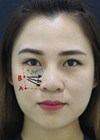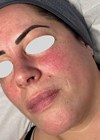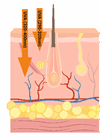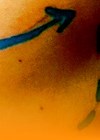Micro laser coring is an advanced skin rejuvenation technique offering great precision, customisable treatment and effective skin remodelling. Using the Fotona F-Runner scanner with fractional Er:YAG laser energy, this procedure removes ultra-fine, 250µm wide micro columns of tissue through vaporisation, triggering a powerful wound healing response that stimulates collagen and elastin production. Below, I outline my approach to patient selection, procedural execution, and post-treatment care.
Patient selection and preparation
Micro laser coring is ideal for patients seeking deep wrinkle reduction, acne scar remodelling and skin tightening. Its ability to utilise cold pulses reduces the risk of hyperpigmentation. However, the option of adding a thermal component to the treatment, by prolonging the pulse duration, also makes it an ideal tool for addressing scar remodelling, ranging from atrophic acne scars to hypertrophic scars.
Before treatment, the patient’s face is cleansed and disinfected and a topical anaesthetic cream is applied for at least half an hour. Micro laser coring offers pre-set parameters that you can choose based on the skin pathology. Deep settings are used for pronounced wrinkles and scars, while medium settings are used for a milder rejuvenation. I always combine different settings within a single session to target specific problem areas more effectively.

Figure 1: Before.

Figure 2: Immediately after.

Figure 3: After one week.
Procedure execution
Micro laser coring vaporises tiny columns of skin tissue with extreme precision, creating controlled micro injuries that accelerate collagen renewal. The coverage area can be set from 5–20%, which is ideal for addressing deeper wrinkles or scars. An advantage of micro laser coring over hollow needle micro coring is its ability to incorporate heat as needed. Cold pulses are used for wrinkle reduction to minimise downtime, while acne scar treatments often benefit from added thermal energy to enhance skin remodelling. This level of customisation and the precise control of laser energy ensures less trauma, resulting in a faster recovery process and more effective treatment.
- Step 1: I perform the first pass with lower settings over the whole treated area, ensuring a lot of overlapping between laser pulses to achieve a coverage of around 15%.
- Step 2: I increase the fluence and perform an additional 1–2 passes over more problematic areas, with deeper wrinkles or acne scars.
Throughout the procedure, I monitor patient comfort and skin reaction and adjust the settings as needed.
Post-treatment care and recovery
After treatment, I apply a silicone gel followed by an occlusive cream, like Aquaphor, for the first two to three days. Patients then transition to a repair cream, such as Cicaplast, combined with their regular moisturiser to support healing. Patients must use sun protection for at least two weeks. Strict hygiene is crucial, and patients must avoid dusty environments, pools and saunas. Strenuous exercise should also be avoided for a few days to prevent delayed healing.
Medium settings result in minor redness and scabbing that resolve within three days, while deep settings extend downtime to a few days. Adding a thermal component to the treatment will prolong downtime, especially redness, for one to two weeks.
Assessing results and follow-up
I take pre-treatment photographs, followed by post-treatment photographs one month after the final session. Improvements include better skin texture, a reduction in wrinkles and pore size, and an overall tightening effect. In acne scar treatments, scars become less visible and more level with the surrounding skin. On top of this, patient satisfaction provides valuable insight into the perceived effectiveness of the treatment.
Micro laser coring delivers precise, customisable treatments tailored to each patient, achieving outstanding results in skin rejuvenation and scar remodelling.
Declaration of competing interests: Tea Osterc Diwersy is a clinical expert at Fotona d.o.o., the manufacturer of the Dynamis laser devices.










